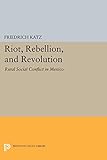Riot, Rebellion, and Revolution : Rural Social Conflict in Mexico / ed. by Friedrich Katz.
Material type: TextSeries: Princeton Legacy Library ; 979Publisher: Princeton, NJ : Princeton University Press, [2014]Copyright date: ©1988Edition: Course BookDescription: 1 online resource (606 p.)Content type:
TextSeries: Princeton Legacy Library ; 979Publisher: Princeton, NJ : Princeton University Press, [2014]Copyright date: ©1988Edition: Course BookDescription: 1 online resource (606 p.)Content type: - 9780691607993
- 9781400860128
- 972 19
- F1228.9
- online - DeGruyter
- Issued also in print.
| Item type | Current library | Call number | URL | Status | Notes | Barcode | |
|---|---|---|---|---|---|---|---|
 eBook
eBook
|
Biblioteca "Angelicum" Pont. Univ. S.Tommaso d'Aquino Nuvola online | online - DeGruyter (Browse shelf(Opens below)) | Online access | Not for loan (Accesso limitato) | Accesso per gli utenti autorizzati / Access for authorized users | (dgr)9781400860128 |
Frontmatter -- CONTENTS -- PREFACE -- CHAPTER ONE. Introduction: Rural Revolts in Mexico -- PART I. Mexico: Unique Center of Rural Rebellion? -- CHAPTER TWO. Patterns of Rural Rebellion in Latin America: Mexico in Comparative Perspective -- PART II: Pax Hispanica? -- CHAPTER THREE. Rural Uprisings in Preconquest and Colonial Mexico -- CHAPTER FOUR. Agrarian Social Change and Peasant Rebellion in Nineteenth-Century Mexico: The Example of Chalco -- CHAPTER FIVE. Peasant Rebellion in the Northwest: The Yaqui Indians of Sonora, 1740-1976 -- CHAPTER SIX. Moving Toward Revolt: Agrarian Origins of the Hidalgo Rebellion in the Guadalajara Region -- CHAPTER SEVEN. Banditry and Insurrection: Rural Unrest in Central Jalisco, 1790-1816 -- PART III. From Indian Rebellions to Peasant Revolts -- CHAPTER EIGHT. The 1840s Southwestern Mexico Peasants' War: Conflict in a Transitional Society -- CHAPTER NINE. The Sierra Gorda Peasant Rebellion, 1847-50 -- CHAPTER TEN. Revolts and Peasant Mobilizations in Yucatan: Indians, Peons, and Peasants from the Caste War to the Revolution -- PART IV. Peasants and Peons in the Mexican Revolution -- CHAPTER ELEVEN. The Political Project of Zapatismo -- CHAPTER TWELVE. "Neither Carranza nor Zapata!": The Rise and Fall of a Peasant Movement that Tried to Challenge Both, Tlaxcala, 1910-19 -- CHAPTER THIRTEEN. Agricultural Laborers in the Mexican Revolution (1910-40): Some Hypotheses and Facts about Participation and Restraint in the Highlands of Puebla-Tlaxcala -- CHAPTER FOURTEEN. Charisma, Tradition, and Caciquismo: Revolution in San Luis Potosí -- CHAPTER FIFTEEN. Second Division of the North: Formation and Fragmentation of the Laguna's Popular Movement, 1910-11 -- CHAPTER SIXTEEN. Peasants and the Shaping of the Revolutionary State, 1910-40 -- PART V. Nineteenth- and Twentieth-Century Revolts in Perspective -- CHAPTER SEVENTEEN. Rural Rebellions after 1810 -- CHAPTER EIGHTEEN. Economic Fluctuations and Social Unrest in Oaxaca, 1701-94 -- GLOSSARY OF SPANISH TERMS -- NOTES ON CONTRIBUTORS -- INDEX
restricted access online access with authorization star
http://purl.org/coar/access_right/c_16ec
Since the Mexican Revolution of 1910-1920, Mexico's rebellious peasant has become a subject not only of history but of literature, film, and paintings. With his sombrero, his machete, and his rifle, he marches or rides through countless Hollywood or Mexican films, killing brutal overseers, hacienda owners, corrupt officials, and federal soldiers. Some of Mexico's greatest painters, such as Diego Rivera, have portrayed him as one of the motive forces of Mexican history. Was this in fact the case? Or are we dealing with a legend forged in the aftermath of the Revolution and applied to the Revolution itself and to earlier periods of Mexican history? This is one of the main questions discussed by the international group of scholars whose work is gathered in this volume. They address the subject of agrarian revolts in Mexico from the pre-Columbian period through the twentieth century. The volume offers a unique perspective not only on Mexican riots, rebellions, and revolutions through time but also on Mexican social movements in contrast to those in the rest of Latin America.The contributors to the volume are Ulises Beltran, Raymond Buve, John Coatsworth, Romana Falcon, John M. Hart, Evelyn Hu-DeHart, Friedrich Katz, William K. Meyers, Enrique Montalvo Ortega, Herbert J. Nickel, Leticia Reina, William Taylor, Hans Werner Tobler, John Tutino, Arturo Warman, and Eric Van Young.Originally published in 1988.The Princeton Legacy Library uses the latest print-on-demand technology to again make available previously out-of-print books from the distinguished backlist of Princeton University Press. These editions preserve the original texts of these important books while presenting them in durable paperback and hardcover editions. The goal of the Princeton Legacy Library is to vastly increase access to the rich scholarly heritage found in the thousands of books published by Princeton University Press since its founding in 1905.
Issued also in print.
Mode of access: Internet via World Wide Web.
In English.
Description based on online resource; title from PDF title page (publisher's Web site, viewed 30. Aug 2021)


